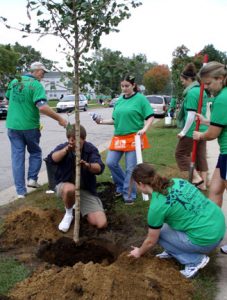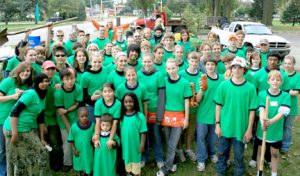2008 Fall RNeighborWoods Planting
On Saturday, September 27, over 175 school and service groups, neighbors, families, RNeighborWoods partners, volunteers, and Citizen Foresters joined together in a morning of service to plant 100 new trees in the southeast Rochester neighborhood of Homestead Park. Thanks to the Olmsted County Youth Commission, youth came out in force to green up this neighborhood. All local high schools were represented, including Stewartville and Byron.
A high density of open boulevard tree spaces and neighbors without the means to plant trees is one of the criteria that the RNeighborWoods group uses to determine which neighborhood they target for a community tree planting. According to Jacob Ryg, Rochester’s City Forester, there were only four trees standing on Homestead Lane, out of 110 total boulevard tree planting spaces.

In the 1960’s trees were planted in this neighborhood following the planting practices of the day. All of the trees were planted too deep, and eventually suffered from stem girdling roots and had to be taken down. None had been replanted until Saturday.
An RNeighbors program, RNeighborWoods partners worked for months to organize this successful event and include Herring Exterior Design, Maier Forest & Tree, Olmsted County Youth Commission, Olmsted County Vital Aging Commission, Rochester City Forester, Rochester Public Utilities, and Quarry Hill Nature Center.
Local business were generous in providing refreshments for the planters including BP Pump N’ Munch Convenience Stores, Panera Bread, and Home Depot. Sponsors stepped forward to provide the volunteers with a colorful RNeighborWoods t-shirt. This RNeighborWoods planting was part of a national day of service, through Service Nation, to encourage citizen service in our country and our neighborhoods.
Since 2006, the RNeighborWoods group has planted 200 seedlings and 820 ball-in-burlap and container trees on Rochester boulevards. Trees for this community planting were purchased by the City of Rochester and RPU.
Urban trees are vital to the health of neighborhoods. Frances Kuo and Bill Sullivan of the University of Illinois Human-Environment Research Laboratory have studied how residents in a public housing project in Chicago lived their daily lives based on the amount of contact they had with trees. “People who live in intense poverty have to count on their neighbors for a lot of the social support that they need in their lives,” said Bill Sullivan. “We’re finding trees produce settings in which neighbors get to know each other better and violence is reduced. Therefore, trees are associated with the reduction of one of our most significant important public policy concerns of the day.”
Have a comment? Join us on Facebook!

